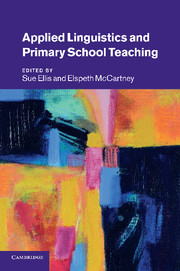Book contents
- Frontmatter
- Contents
- List of figures
- List of tables
- Notes on contributors
- Preface
- Editors' notes and conventions
- Introduction
- Part I Policy and diversity in the twenty-first-century primary school
- Part II The range and focus of applied linguistics research
- Introduction to Part II
- 6 Grammar for designers: how grammar supports the development of writing
- 7 The use of corpus-based approaches in children's knowledge about language
- 8 Words and pictures: towards a linguistic understanding of picture books and reading pedagogy
- 9 From storytellers to narrators: how can the history of reading help with understanding reading comprehension?
- 10 Talk about text: the discursive construction of what it means to be a reader
- 11 Why we need to know about more than phonics to teach English literacy
- 12 Understanding children's reading comprehension difficulties
- 13 Classroom discourse: the promise and complexity of dialogic practice
- 14 Pedagogy and bilingual pupils in primary schools: certainties from applied linguistics
- Part III Empowering teachers and teachers' use of knowledge
- References
- Index
13 - Classroom discourse: the promise and complexity of dialogic practice
Published online by Cambridge University Press: 26 April 2011
- Frontmatter
- Contents
- List of figures
- List of tables
- Notes on contributors
- Preface
- Editors' notes and conventions
- Introduction
- Part I Policy and diversity in the twenty-first-century primary school
- Part II The range and focus of applied linguistics research
- Introduction to Part II
- 6 Grammar for designers: how grammar supports the development of writing
- 7 The use of corpus-based approaches in children's knowledge about language
- 8 Words and pictures: towards a linguistic understanding of picture books and reading pedagogy
- 9 From storytellers to narrators: how can the history of reading help with understanding reading comprehension?
- 10 Talk about text: the discursive construction of what it means to be a reader
- 11 Why we need to know about more than phonics to teach English literacy
- 12 Understanding children's reading comprehension difficulties
- 13 Classroom discourse: the promise and complexity of dialogic practice
- 14 Pedagogy and bilingual pupils in primary schools: certainties from applied linguistics
- Part III Empowering teachers and teachers' use of knowledge
- References
- Index
Summary
Introduction
We estimate that, on average, an English primary teacher poses over 60,000 questions and follows up pupil responses with over 30,000 evaluations in every year of classroom lessons. This talk is shaped by deeply ingrained habits, resulting in part from an estimated 13,000 hours spent as a pupil watching others' teaching practice (Lortie 1975). However, a recent resurgence of interest in classroom discourse among educational researchers and policy makers is focusing attention on patterns of teacher talk. This attention, in turn, is placing demands upon teachers that they transform their talk, making conscious and informed choices about what had heretofore normally been second nature.
How should teachers and teacher educators respond to these demands? What do they need to know and understand about classroom discourse? In addressing these questions we review a broad consensus emerging from three decades of research on the topic, according to which (i) the way teachers and pupils talk in the classroom is crucially important, but (ii) the dominant pattern of classroom discourse is problematically monologic, so (iii) it should be replaced with more dialogic models. While we find much merit in this conventional wisdom, in this chapter we also show its limitations, arguing that teaching and classroom interaction are far more complicated and problematic than is typically captured by descriptions of and prescriptions for dialogue.
Information
- Type
- Chapter
- Information
- Applied Linguistics and Primary School Teaching , pp. 165 - 185Publisher: Cambridge University PressPrint publication year: 2011
Accessibility standard: Unknown
Why this information is here
This section outlines the accessibility features of this content - including support for screen readers, full keyboard navigation and high-contrast display options. This may not be relevant for you.Accessibility Information
- 18
- Cited by
